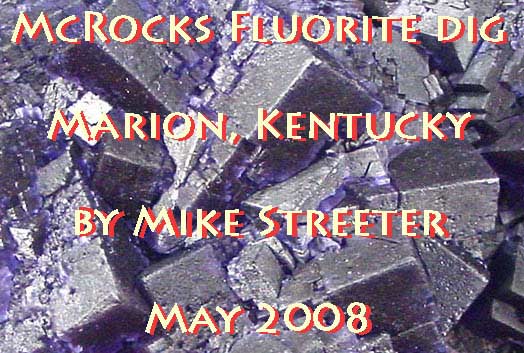The
Ben E. Clement Mineral Museum in Marion, Kentucky contains the world's largest collection of fluorite (also known as fluorspar). Mr. Clement assembled
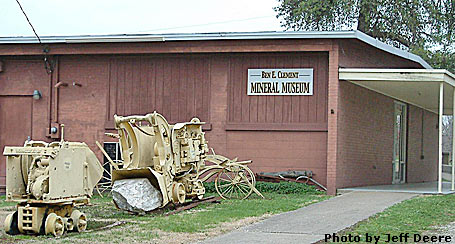
over 50,000 pieces of fluorspar from 1920 until his death in 1980. The museum is filled with an untold number of specimens that would be the envy of any collector and even the Smithsonian. In addition to guided tours of the museum, the Clement conducts fee-based field trips to local fluorite mines and prospects, including the Columbia Mine and Eureka Prospect. In addition to fluorite, smithsonite, sphalerite, cerussite, galena, hemimorphite, hydrozincite, quartz, & pyromorphite may be found in spoil pile material.
When James Johnson proposed a group field trip to the Clement Museum and its mines and prospects on the McRocks.com message board, he received many positive responses. Therefore, he arranged with the Clement personnel to conduct a two-day McRocks dig there for May 10-11, 2008. However, before leading a group field trip to this new-to-us location, James, Chrissy and I agreed that it would be prudent to conduct a reconnaissance trip there and did so in late-March. My report of this prior trip my be seen at the following link: Marion March 2008.
Before continuing with my report of the May field trip, I thought that some of you might enjoy or at least tolerate reading a bit of historical, geographic and geologic background information (if not, you can always scroll past it . . . ).
The Illinois-Kentucky fluorspar district has been famous for fluorite and associated minerals since the early 1800's. The district has been the largest producer of fluorite in the United States; more than 90% of the domestic production in 1985 was from this district. The last operating mine in the district was closed in 1995.
Crittenden County is believed to be the first place in Kentucky where fluorspar was mined. The Kentucky fluorspar region includes the far western counties of Crittenden, Livingston, Caldwell, and Trigg. The Columbia mine near Marion in Crittenden County is the oldest in the Illinois-Kentucky fluorite district and was first worked by a company owned by Andrew Jackson who, in 1835, sank a shaft 40 to 60 feet deep in search of argentiferous galena. About 30 years later, the Columbia Silver Mining Company, who purchased the mine and deepened the shaft to 80 feet, gave the mine its name. The nearby Eureka Prospect consists of at least two shafts and numerous shallow prospect pits adjacent to Hurricane Creek. Information about the Eureka is sketchy, but it is believed that the shafts and pits were dug in the 1940s. The main shaft was filled in, but an unknown shaft was discovered by the landowner, Bill Frazer, in 2005. Kentucky area mining took place on and off until the 1950’s, when it become unprofitable due to overseas competition. Thanks to Mr. Frazer and the Ben E. Clement mineral museum, rockhounds are able, with permission, to access the area mine’s spoil piles to collect fluorite and associated minerals.
The Columbia Mine and Eureka Prospect were developed on the Levias-Crittenden Spring fault system, with Saint Genevieve limestone on the footwall and Chester-age shales and sandstone on the hanging wall. Fluorite formed in hydrothermal lead-zinc ore deposits referred to by geologists as a Mississippi Valley-type deposit (MVTs). MVTs within the Mississippi River drainage basin are the largest in the world and were the first to be studied in detail and, thus, the origin of the name. The most abundant minerals in MVTs are sphalerite, galena, barite, fluorite, calcite, dolomite, quartz and pyrite.
It has long been thought that MVTs are the result of huge hydrothermal systems involving massive quantities of fluids that have traveled hundreds of kilometers. Studies suggest a relationship to major tectonic events that may supply a driving force for these hydrologic systems. Hot water containing fluorine and other dissolved chemicals rose from deep within the earth during the Jurassic Period, about 150 to 200 million years ago, and flowed through northeast-trending faults and fractures into Mississippian-age limestones that were deposited about 330 million years ago. The hydrothermal solutions passed along fault zones and deposited or precipitated the ore and gangue minerals within the open spaces. In some cases, flat-lying beds of limestone appear to have been dissolved and replaced with fluorite and other minerals.
As a geologist I could go on and on with the scientific mumbo jumbo, and it may seem to some of you that I already have, but before your eyes glaze over, what do you say I get back to the actual May field trip?
As was prescribed by James, we met at the Clement Museum at 8:00 AM Saturday to complete liability waiver forms and pay our collecting fees. After about an hour of hanging out in the museum and parking lot, talking rocks and waiting for the stragglers to arrive, we followed Mr. Frazer out to the Columbia and Eureka. While Mr. Frazer showed some in the group the Columbia Mine, several others, including Everett and I went about setting up to collect in the area of the Eureka spoil piles next to Hurricane Creek. Most followed James' and Kathy Daley's lead by tearing into the bottom of the creek and its banks.
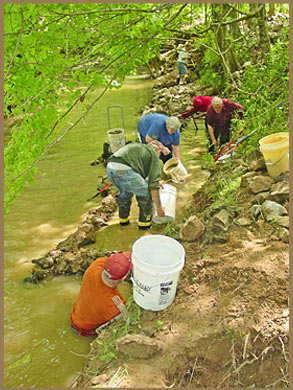
Hurricane Creek Diggers
|
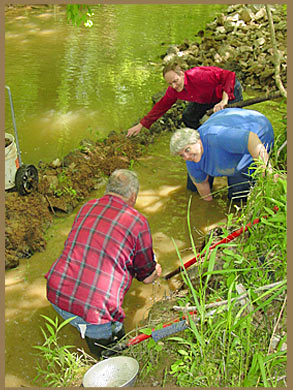
Bill & Kathy Daley of West Virginia
David Reed of Kansas City, MO
|
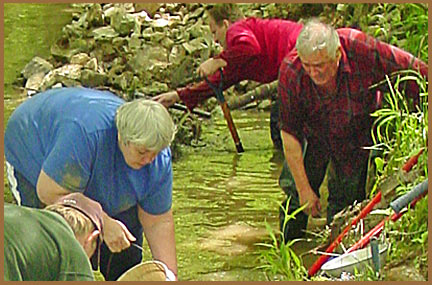
Bill & Kathy
It became a running joke to, every once in a while, hear someone exclaim, "Eureka!" when a particularly good specimen was found. "Eureka", which is Greek for “I have found (it)," was supposedly shouted by the Greek scientist Archimedes over 2000 years ago when he, after long study, discovered a method of detecting the amount of silver alloy mixed with gold in the crown of the king of Syracuse. Supposedly while in his bath, he discovered that if he put the King's crown into the water and then separately placed equal amounts of gold and silver in the water, then the difference in water displacement would tell him how much of each metal was in the crown. This method has come to be known as the Archimedes Principle or specific gravity. “Eureka” has since been adopted as an expression of triumph concerning a discovery, especially in mining. Eureka was an especially fitting word to use considering where we were collecting.
Much of the collecting was done by reaching down to the bottom of the creek to pull out rocks that might contain fluorite. The group attempted, with little success, to isolate their collecting area from the creek by building a dam and bailing water out of the resulting enclosed area adjacent the creek bed. My dear wife, Chrissy, commented with a smile to the group that it appeared to her that the water level inside the enclosed area appeared higher than the creek's and the bailing of water was soon curtailed. It was worth a shot though!
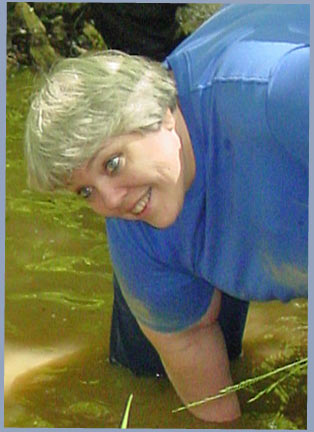
Pure Rockhounding Joy!
|
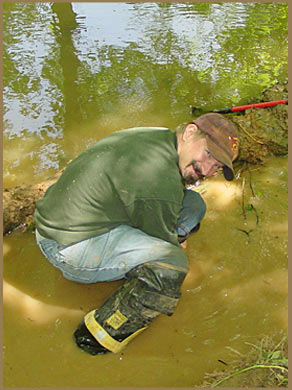
James Johnson
of Sullivan, MO
|
Jim was a little bit non-plussed after he claimed to have been bitten on the hand by a black snake that had been hiding in the creek bank. At the time of the alleged attack, I remember hearing someone holler and then seeing a black snake-like figure sailing through the air to the far side the creek. I found out later that Jim thought that he had been bitten by the snake, although he couldn't be certain if it was the snake or a stick with two points that had struck his hand. In any event, the snake or stick weren't too serious about injuring Jim as the marks either made could barely be seen and the startled serpent was sent on a short trip across the creek where it landed and crawled away uninjured.
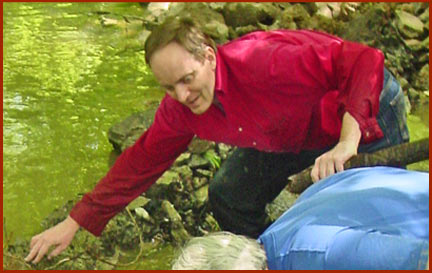
David
|
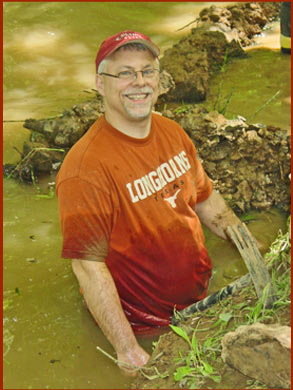
Jim Erickson
of Minneapolis, MN
|
Nobody was more at home playing in and around a creek than our Opal. Once she got in the water, there was no getting her out.
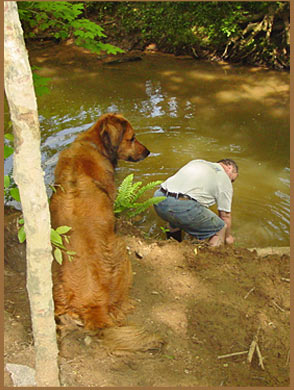
Opal looking for some action
|
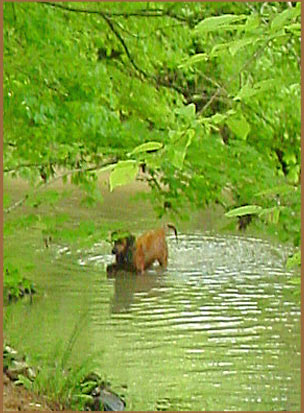
Throw another stick, please!
|
Mr. Frazer stopped by periodically throughout the day to see how we were doing. He was very enthusiastic about everyone's success. Cori who, along with her daughter Abbie, had driven all the way from Oshkosh, Wisconsin to collect, was like kid in a purple candy store.
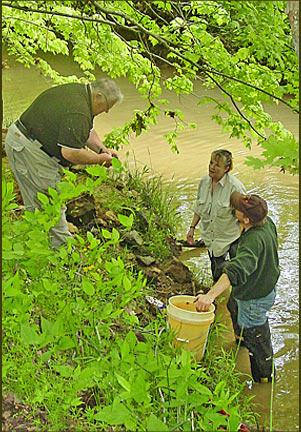
Bill Frazer, Cori Nelson
& James Johnson
|
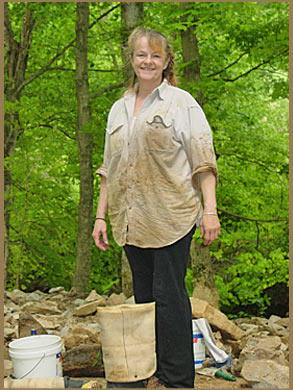
Cori Nelson
of Oshkosh, WI
|
While Opal hunted butterflies without a net, Chrissy discovered an area of exposed bedrock in the creek bed that contained a thin near vertical vein of fluorite and quartz.
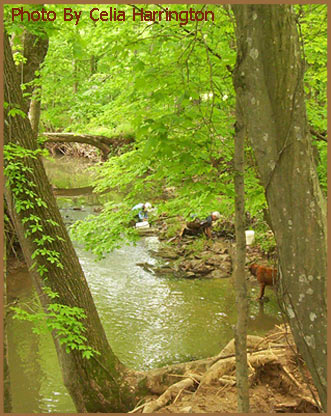
Mike, Chrissy & Opal
on Hurricane Creek
|
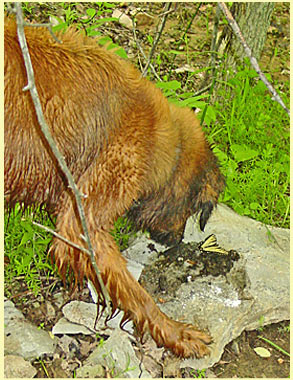
Opal & friend
|
When Chrissy wasn't making her rounds providing help to anyone who needed it, she spent much of her time working the thin vein and retrieved several very pretty specimens, including the following beauty.
Click each specimen picture to enlarge
Those who opted to not get too wet or muddy could collect in the much drier spoil piles - at least drier when Opal wasn't shaking herself off next to you. Young Abbie did quite well on her very first rockhounding trip and uncovered many nice specimens.
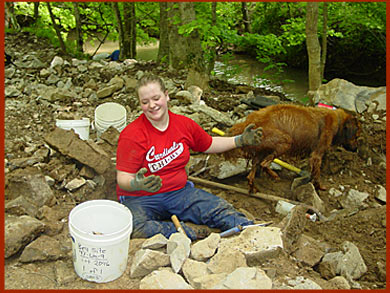
Abbie Nelson
of Oshkosh, WI
|
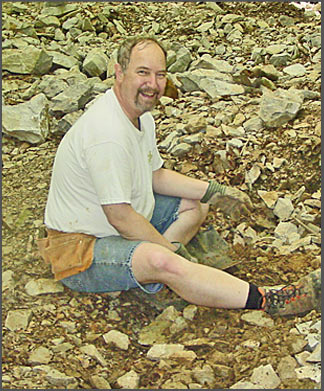
Keith Peregrine
of Philo, Illinois
|
Report continued . . . . . . .
Click Here for Next Page
| 